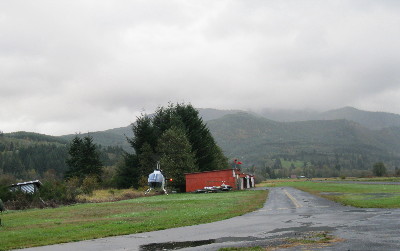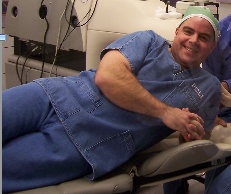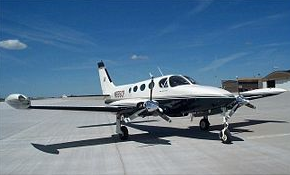
Poor weather conditions in the hills above Morton forced a helicopter to shut down its search Monday, and today severe weather is preventing the recovery of the three victims of the Cessna crash.
By Sharyn L. Decker
Lewis County Sirens news reporter
This news story was updated at 8:45 p.m.
CHEHALIS – Severe weather conditions and rough terrain are hampering the recovery of the victims of the downed Cessna located yesterday in the mountains northeast of Morton.
The Lewis County Sheriff’s Office says there is approximately a foot of snow covering the wreckage of the plane from the Chehalis-based Pacific Cataract and Laser Institute.
“As soon as the weather improves, recovery efforts will be made,” Chief Civil Deputy Stacy Brown said in a news release.
The aircraft was found yesterday morning. None of three men on board survived the crash. The Cessna 340A lost radio contact with air traffic control about 7:45 a.m on Monday after the pilot reported one engine was down.
Co-workers are grieving the loss of the two Pacific Cataract employees and their pilot, according to Debbie Eldredge of Pacific Cataract.
“It is hard to find words to adequately express the grief we feel for the families involved,” Eldredge and president of the company, Dr. Robert O. Ford, said to encourage their staff yesterday in a written statement. “Please continue to hold them up in prayer. We are determined to trust God in every circumstance.”
Ken Sabin of Chehalis was their contract pilot. Rod Rinta, 43, a laser technician, is from Chehalis and Dr. Paul Shenk, 69, comes from Woodland.
Eighty ground teams from five counties assisted yesterday in a search and rescue effort led by the Lewis County Sheriff’s Office.
The crash site is at an elevation of 3,500 feet in a rugged, wooded area some nine miles northeast of Morton. Snow was falling when they found it and continued yesterday. The plane broke apart on impact and is spread over some 75 to 100 yards, according to Brown.
It’s on private forest land, owned by West Fork Timber, Brown said. Their employees, along with workers from Port Blakely joined the search dogs, ATVs and others in the efforts at rescue and recovery.
Four Lewis County Coroner’s Office employees in a four-wheel drive Ford Explorer were led up a slippery logging road yesterday when the weather turned and they were told to turn around.
“We got three to four miles from the site and got word to head out,” Chief Deputy Coroner Dawn Harris said.
It remains unsafe to make another attempt today, according to the sheriff’s office.
The news of no survivors was a devastating blow to a close-knit company, according to Eldredge.
Pacific Cataract keeps a handful of planes at the Chehalis-Centralia Airport to fly surgeons to satellite clinics. The twin-engine plane was heading for Lewiston, Idaho.
Rinta is remembered for his energy and enthusiasm for life, his cheerful outlook and love of working on and maintaining the lasers used throughout the organization, Eldredge said in a news release yesterday.
Dr. Shenk, an ophthalmologist, was one of the most experienced LASIK surgeons in the country, according to Eldredge.
“(He) is remembered for his soft-spoken words and kindness to everyone, his humble manner and how he made people feel special and earned their trust,” she wrote.
Pacific Cataract called Sabin a dependable pilot who was more than trustworthy.
“Ken Sabin is remembered for his professional conduct at all time, his gentle manner, punctuality and conscientious attention to detail,” Eldredge wrote.
Sabin, who retired from Security State Bank in recent years, has more than 40 years experience as a pilot and has been a member of the Centralia-Chehalis Airport Governing Board for about five years, according to airport manager Allyn Roe.
In a prepared statement today, the board wrote: “Ken’s life was one of selfless giving to his community and love of aviation, and while we celebrate a wonderful life and salute his achievements – we will miss him tremendously.”
No accident of this magnitude has been connected with the airport since Roe was hired in 2007, the airport manager said.
On Monday morning, after the office was notified by the Federal Aviation Administration, one of the first things Roe did was check an online flight tracking system to see the altitude, speed and other details recorded for the Cessna’s flight.
It’s a useful web site the airport uses daily – flightaware.com – but in this case the information was flawed, Roe said.
“Sometimes it does get anomalies and in this case there is an anomaly,” he said.
The six-seater plane would have been expected to travel at about 15,000 feet, according to Roe.
While Pacific Cataract has some jets in its fleet, this was not one of them, he said. The FAA registry shows the Cessna was manufactured in 1982.
FAA Regional spokesperson Allen Kenitzer said today investigators from both the FAA and the National Transportation Safety Board will go to the crash scene, as soon as conditions allow.
“Not much is known at this time,” Kenitzer said.
The FAA will check the plane, its logs, the pilot logs and pilot’s history and turn its information over to the NTSB, he said.
The NTSB will examine the aircraft and determine the likely cause of the crash, he said.
Tags: By Sharyn L. Decker, news reporter


